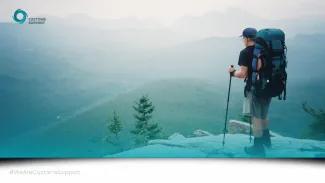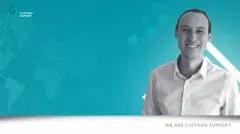I did not know what a declarant did. In fact, I had never heard of it. I never knew that there was a whole industry at work at the four border crossings in the area at that time. I would soon find out and a whole new world opened up for me.
A start as an apprentice declarant
The term apprentice declarant was pretty flattering. Office. boy was the term that better covered the load. That is how I was called by my colleagues towards clients and customs. That was all I could do at the time. My job was to walk to customs with piles of papers and go from counter to counter. In those days, you first had to export from Germany and only then import into the Netherlands. Fortunately, both departments were in the same building and no more than 10 metres apart.
Always ball
So I had found out that all those lorries at the border crossings were not just there for a ball sandwich at the restaurant. They were all there because they had to be: without the intervention of a declarant they would not cross the border. The nice thing about it was that you had frequent customers, you got to know the drivers. They all spoke Dutch and knew their way around. They were all patient because they knew they had to wait anyway. So after handing over the papers, it was off to the restaurant for a shower and that meatball sandwich.
The vocational training and my first own declaration
But what kind of papers were needed? I wanted to know more and was aspired to more than just walking around with papers. Surely the forms lying in the desk drawer had to have a function? What, how, why? I received an offer to follow the EVO vocational training course and grabbed it with both hands. I wanted to learn what a D31 and D32 was, a T2 and T1. What were they for? I found out soon enough. Better still, I was allowed to start making simple declarations myself.
It started with making T2 documents. Based on the German export document, I was allowed to fill in a form pre-printed with company name using carbon paper and make a document out of it. With this, I could go to German customs, get the necessary stamps and my first real document (to Great Britain!) was a fact. From there it went on step by step with simple import documents.
Typewriters and a telex
The average freight forwarder and declarant office of the time could be described as follows. There were a few important items that were necessary to be able to carry out the work: a good chair, a desk with drawers, a monstrous typewriter and the Kluwer, or declarants' bible, the Customs Tariff. With chapters 1 to 99 neatly divided over two volumes. For communication you had a telephone and a telex at your disposal. Pre-notification of shipments was rare, the drivers simply reported physically to the counter and then you could get to work.
Faxes and computers
As is well known, the developments from the 80s onwards went very fast, especially in the field of technology. The telex was replaced by fax, with thermal paper. Computers appeared, with a working memory smaller than the average picture on a current smartphone. But customs did not stand still either. The Single Administrative Document was introduced, making all loose documents obsolete. Not forgetting, of course, Sagitta was introduced. The automated customs system. From that moment on, it was no longer necessary to go to customs to get stamps for an import declaration.
After the Maastricht Treaty came into force in 1993, the world of declarants was hit hard; many were dismissed because there would be no more work due to free trade. In retrospect, nothing could be further from the truth.
Digital customs processes
Look where we are now. The world has become digital. We import and export to the farthest corners of the world and everything requires documents. Of course, a lot has been simplified over the years, you don't have to physically go to customs anymore, you can make your declaration throughout the country. The profession is continuously developing, in legislation (DWU) and automation (AGS), AEO, compliance, it never stands still.
The profession is sometimes called dull and stuffy, but it is anything but that. It is exciting, hectic, varied, international and above all interesting. - Franc van Baar
Brexit: we are looking for the border again
Now, 2021, Brexit is a fact. Nobody expected that it would take such a flight, that it would involve so much. The volumes are large and always have been, only after 1993 people no longer realised this. The fact that Great Britain is now a so-called third country for which import and export formalities have to be carried out has suddenly put the profession of the declarant in the spotlight. Vacancies are flying around, people in the profession are being approached to make the switch. Whether it is a customs and trade officer, a customs consultant or just a declarant, they are hard to find.
Signpost in a maze of rules
The profession is sometimes called dull and stuffy, but it is anything but that. It is exciting, hectic, varied, international and above all interesting. It is a profession that you learn not only through training but especially, with a nice Dutch term, on the job. You learn the tricks of the trade by doing and by cooperating with 'old hands' who have worked with typewriters. This interaction between the analogue and digital generation also makes it fun. You learn from each other. It requires flexibility, but you can develop a passion for it. How nice it is when you manage to complete a complex declaration. Not only the client is happy then, but also you as a declarant. You have gained a bit of experience. That is what makes the profession so enjoyable: every declaration is different and so is every day. You are the guide in a maze of (international) regulations and procedures and you know where the exit is!















